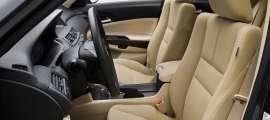We Have a Problem with Car Seats and Our Backs
What is the problem with the way driver and passenger car seats are designed?
In the picture above, which represents a 2014 GMC Sierra SLT, there is decent alignment for the spine. It's not perfect, but it's better than most car seats I've seen. For most car seats, there is a leaning back seat with a head rest that goes forward. This is bad for the human spine and your back.
Here's an example of a horribly designed car seat for ergonomics:

The biggest problem is there is no lower back (lumbar) support and the top of the seat forces the neck forward.
In addition, when I look at the inside of the Tesla Model S Plaid, the car seats are not designed for ergonomics. It's one of the only criticisms I have for the car.
The following is a tweet from what a proper ergonomic seat should be like in a car. The lower back should have lumbar support and curve forward, and the neck should also have the same support alignment that the lower back has. The neck should be supported with the curve forward - not the top of the head above the neck. This is an important distinction.
#healthygirl #fitspo Ergonomic Car Seat Waist Cushion pic.twitter.com/c622Xy1pwe— BraceYouPro Store (@braceyoupro) October 29, 2020
I understand the concern with whip lash and the head if an accident happens. You don't want to have problems with your neck in an accident, which is why cars have head supports that push forward. Unfortunately, this means most of the time, your neck is going to curve forward, which is bad for your spine.
Are there any ergonomic options for your car?
Right now, in order to have ergonomics for your car and to support your spine, you have to buy accessories. Car makers aren't going to do ergonomics, likely because the cost just isn't worth it. It's easier to make a standard seat just like everyone else is doing. But here are some options:
Lumbar support
A typical Lumbar support for your lower back will run around $25 to $50 depending on the type of support you choose. After looking at Amazon.com, this was the conclusion I came to. Here were a couple popular options:
Neck support
You can buy a neck support for your neck for your car and that will run between $15 and $25 depending on the type of support you choose. Looking at Amazon.com, this was the conclusion I came to. Here were a couple popular options:
All in all, you can expect to spend between $50 to $100 to give yourself the needed ergonomic support for your car.
What does the perfect ergonomic car seat look like?
The best example I could find of what a driver car seat should look like is from the following Tweet:
This Ergonomic Office Chair is available on our website. Kindly visit our website to place your order. #wednesdaythought #onlinestore #onlineshopping #office pic.twitter.com/tQgGjFuGSn— Amgray Commerce (@AmgrayCommerce) June 2, 2021
If I were Tesla, I would find a way to create a front car seat like this and make it standard for all cars. You could even make the lumbar and neck support as addons that can be added and removed or adjusted as needed. I understand that the cost of addons is pretty low compared to the price of the car, and I predict that Tesla won't do anything due to the ease of buying addon's yourself. Plus, full self-driving is coming and won't require people to sit and drive anyway…
I have an office chair that I work in at home that has great lumbar support and neck support. It's essential for the amount of time I spend sitting.
What do you think – are ergonomics important for cars? Do you use any extra add-ons to give you Lumbar support? Should Tesla and other car manufacturers pay more attention to ergonomics for the spine?
Leave your comments below, share the article with friends and tweet it out to your followers.
Jeremy Johnson is a Tesla investor and supporter. He first invested in Tesla in 2017 after years of following Elon Musk and admiring his work ethic and intelligence. Since then, he's become a Tesla bull, covering anything about Tesla he can find, while also dabbling in other electric vehicle companies. Jeremy covers Tesla developments at Torque News. You can follow him on Twitter, Facebook, LinkedIn and Instagram to stay in touch and follow his Tesla news coverage on Torque News.

